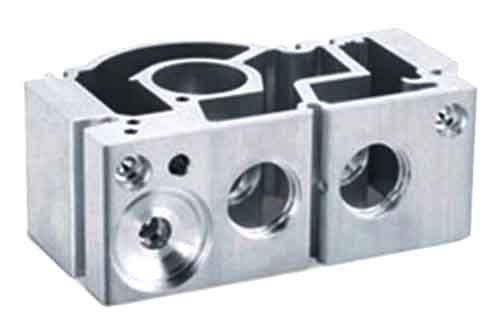V nedávnom prototype obrábanie nového produktu spoločnosti, some of the workpieces are made of stainless steel and other difficult-to-CNC machining materials, such as 3Cr13, 3Cr13Mo, 40CrNiMo, 9CrMoV, atď. Workpieces of this type have also been processed in the past. Although the production efficiency is low, the batches are small, the quantity is small, and the production cycle is short. After mass production, the problems were exposed, the tools were severely worn, the number of sharpenings increased, and the downtime and machine tool adjustment time increased. The surface roughness of the workpiece is poor, the chips are not easy to curl and break, and the processed surface of the workpiece is scratched, which directly affects the quality of the workpiece.
The material of the workpiece is 3Cr13Mo, and the process requirements are processed by CNC lathe except for the grinding of each outer circle of Ra0.8µm. The strength, elongation, reduction of area, and impact performance of 3Cr13Mo steel are higher than those of 40 steel and 45 oceľ. It is a medium carbon martensitic stainless steel with high strength and good plasticity. During the trial production of the workpiece, skúška sústružením ocele 3Cr13Mo bola vykonaná podľa technologického spôsobu sústruženia obyčajnej uhlíkovej ocele. Výsledkom je silné pracovné spevnenie počas rezania, vysoký rezný odpor, vysoká teplota rezania, a ľahké prilepenie nástroja, čo má za následok vybudovaný okraj. Spôsobuje zmenu veľkosti obrobku a ovplyvňuje toleranciu tvaru a polohy a drsnosť povrchu obrobku.
V reakcii na vyššie uvedené problémy, boli prijaté opatrenia z viacerých hľadísk, aby opracovaný povrch obrobku dosiahol veľkosť a drsnosť povrchu požadovanú vzorom, a zabezpečiť vysokú efektivitu výroby.

Kontrola kvality obrábania dielov z nehrdzavejúcej ocele
1. Tepelné spracovanie mení tvrdosť materiálu
Rozdielna tvrdosť martenzitickej nehrdzavejúcej ocele po tepelnom spracovaní má veľký vplyv na sústružnícke spracovanie. Tabuľka 1 ukazuje použitie nástrojov na sústruženie materiálu YW2 po sústružení a tepelnom spracovaní obrobkov z materiálu 3Cr13M rôznej tvrdosti. Je to vidieť z tabuľky 1 že hoci žíhaná martenzitická nehrdzavejúca oceľ má nízku tvrdosť, jeho otáčavý výkon je slabý. Je to preto, že materiál má veľkú plasticitu a húževnatosť, nerovnomerná štruktúra, silná priľnavosť a fúzia, a je ľahké vyrábať hrany nožov počas procesu rezania, a nie je ľahké dosiahnuť dobrú kvalitu povrchu. Po ochladení a temperovaní, obrobok z materiálu 3Cr13Mo s tvrdosťou nižšou ako 30HRC má lepšiu opracovateľnosť a je ľahké dosiahnuť lepšiu kvalitu povrchu. Aj keď kvalita povrchu obrobku s tvrdosťou väčšou ako 30HRC je lepšia, sústružnícky nástroj je náchylný na opotrebovanie. Preto, the quenching and tempering treatment is carried out before the machining, the hardness reaches 25-30HRC, and then the cutting is carried out.
2. Cutting tool materials for machining martensitic stainless steel
The cutting performance of the tool material is related to the durability and productivity of the tool. The manufacturability of the tool material affects the manufacturing and sharpening quality of the tool itself.
The principle of selecting materials for the cutting part of the tool is to have high wear resistance and maintain its cutting performance at a higher temperature.
Currently commonly used turning tool materials are: High-speed steel and cemented carbide. Because high-speed steel can only maintain its cutting performance below 600°C, vysoká teplota vznikajúca pri rezaní nehrdzavejúcej ocele je často vyššia ako 600 °C. A slinutý karbid má lepšiu tepelnú odolnosť a odolnosť proti opotrebovaniu ako rýchlorezná oceľ, takže nástroje vyrobené zo slinutých karbidových materiálov sú vhodnejšie na rezanie nehrdzavejúcej ocele. Za podmienok rovnakých rezných parametrov, bola vykonaná porovnávacia skúška otáčaním na nástrojoch z niekoľkých zliatinových materiálov.
Vonkajší sústružnícky nástroj s čepeľou s kompozitným povlakom TiC-TiCN-TiN má vysokú odolnosť, dobrá kvalita povrchu a vysoká produktivita. Je to preto, že čepeľ potiahnutá materiálom zo slinutého karbidu má lepšiu pevnosť a húževnatosť. A pretože jeho povrch má vyššiu tvrdosť a odolnosť proti opotrebeniu, menší koeficient trenia a vyššia tepelná odolnosť, it has become a good tool material for turning stainless steel. Limited to cutting blades that do not have this material, the comparison test in Table 2 shows that the cutting performance of YW2 cemented carbide is also better, so you can choose YW2 material blades as the cutting blade.
 English
English العربية
العربية 中文(漢字)
中文(漢字) Čeština
Čeština Dansk
Dansk Nederlands
Nederlands Suomi
Suomi Français
Français Deutsch
Deutsch Italiano
Italiano 日本語
日本語 ಕನ್ನಡ
ಕನ್ನಡ 한국어
한국어 Português
Português Русский
Русский Slovenčina
Slovenčina Español
Español Svenska
Svenska Türkçe
Türkçe

